Edward
Lewis Evans was born May 1, 1858 in New Orleans, Louisiana. He was a young man
of twenty five years when he arrived by coastal steamer in Fort Myers, Florida in 1883. Evans landed a job as a clerk in schooner captain Henry L. Roan’s store
and settled down to stay. He would play a major role in transforming the small
village into a major sport fishing destination.
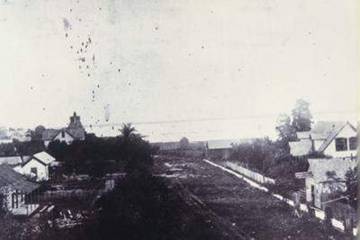
In 1883 Fort Myers was little
more than a hardscrabble cow town along the Caloosahatchee River. Only about fifty families made up the population of fewer than 350 people. Evans
helped incorporate the town in 1885 and helped to organize Lee County two years later. He worked alongside Francis Asbury Hendry, after whom next door Hendry County was named. Hendry would soon become his father in law.
Captain
F.A. Hendry was a veteran of the Seminole Indian Wars and also served The
Confederacy during the Civil War. He was assigned to the Commissary
Department of Florida for three years and supplied several Southern armies with
large herds of cattle before commanding his own cow cavalry company in 1864.
At one time Hendry owned more livestock than anyone else in Florida. He would
come to be known as “The Father of Fort Myers”. In 1887 Edward Evans married his
daughter Carrie Belle Hendry. The town of LaBelle, Florida is the County Seat
of Hendry County and was named after Carrie Belle and her sister Laura June.
Evans
was working at Roan’s store one day in March 1885 when a gentleman walked in to
ask about the local fishing. Thomas Edison had been visiting in St. Augustine that winter and was making his first trip to Fort Myers. He was intrigued
by the possibility that the local canebreak bamboo might be the answer he
sought for a lasting fiber for his light bulb filament. The famous inventor
had a great passion for fishing and it was a passion shared by Edward Evans.
The store clerk was so enthusiastic about the fishing in the Fort Myers area that
he was able to persuade Edison to stay and establish a residence. Edward Evans
and Thomas Edison formed a very close life long friendship.
Within
only a few days Edison acquired a thirteen acre tract of land along the Caloosahatchee River. Plans were made and construction began soon after for what came to
be known as Seminole Lodge, Edison’s winter estate and laboratory. Edison and
his second wife Mina spent their honeymoon in Fort Myers the following year and
were able to spend several days at Seminole Lodge as construction neared
completion. They spent their first winter in the completed home the following
year. An epidemic of yellow fever led to quarantine in Fort Myers only a couple
of weeks after they left. Thomas and Mina Edison would not return again until
1901. Instead they stayed at their New Jersey Glenmont estate as they raised
their new family of three children.
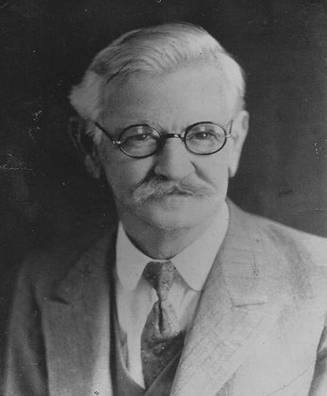
Ed Evans had good reason to be
enthusiastic when he told Edison about the fishing around Fort Myers. Redfish,
snook, and trout were plentiful in the local waters and huge schools of big tarpon
gathered in the river and the surrounding bays. Around the time of Edison’s March
1885 visit, New York sportsman William Halsey Wood was able to catch one of
these silver king giants on rod and reel in nearby Tarpon Bay. His fish was
nearly six feet in length and weighed 93 pounds. He would catch four more
large tarpon near the mouth of the Caloosahatchee River during his visit. Though
there is some controversy whether Wood was the first man to ever catch a tarpon
on rod and reel, there is no question that his accomplishment brought world
wide publicity to Fort Myers fishing.
Evans was quick to recognize the possibility of making Fort Myers a tourist
destination for tarpon fishermen. He spent much of the rest of his life in
that pursuit. Over the next few years he was active in building the town and
served several terms as councilman, member of the school board, and also served
a term as Mayor. During President Grover Cleveland’s second administration Evans
served as Postmaster of Fort Myers.
City
growth was aided by the return of Edison in 1901, as he and his new family
settled into a routine of spending winters there. Edison spoke highly of Fort Myers and newspapers around the country quickly spread his words. The inventor’s
endorsement soon convinced others to visit or establish residence in Fort Myers. The area became a playground for the wealthy. It was not long before Ambrose
McGregor, Henry Ford, Harvey Firestone, and others became Edison’s neighbors.
Edward
Evans’ great love was fishing and he earned a reputation as one of the finest
tarpon fishermen in the area. Captain Evans once brought a 180 pounder to the
boat and insisted on releasing the fish to fight again another day. He was
among the first to promote catch and release of the silver kings.
By 1900
the population of Fort Myers had grown to 943 people. Ed Evans formed a
partnership with local business developer Harvey Heitman and they opened the
Heitman-Evans Company. Their hardware store was located downtown on the corner
of First and Hendry streets. Ed Evans was the store manager. The ground floor
of the old wooden building had previously been the Parker General Store. Phoenix
Hall was the town’s main gathering place and occupied the second floor. In
1913 Heitman constructed a modern brick building across the street and the old
wooden store was torn down. The new Heitman-Evans store still sold hardware,
but it was mostly a sporting goods store and one that dealt primarily in
fishing tackle.
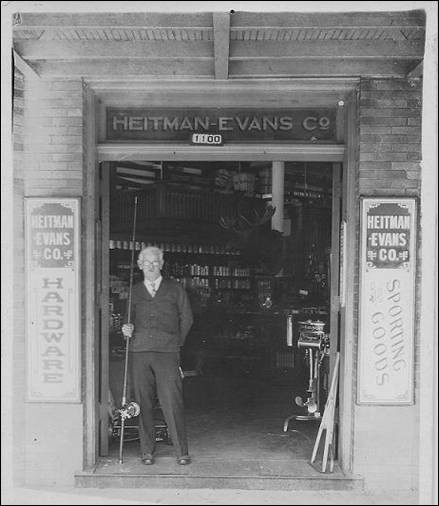
Captain
Ed Evans is seen standing in the doorway of the new Heitman-Evans Company hardware
and sporting goods store. Look very closely and you might be able to see a
moose head mounted over the display case inside the store.
The
Heitman-Evans Company carried a large inventory of the highest quality fishing
tackle available anywhere. They advertised “…Vom Hofe rods, Van Vleck hooks,
the best grades of lines for tarpon, bass, red fish, or other fishing….We handle
the best goods in Fishing Tackle…..Our Rods and Reels are noted the world over
and we invite sportsmen to make this store their headquarters while spending
the season at Fort Myers”.
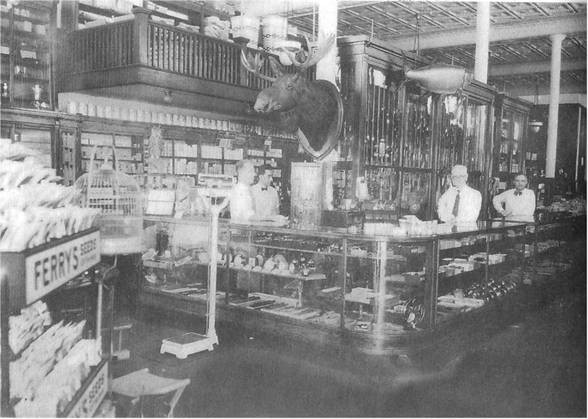 One of the most famous sportsmen
in the world of big game fishing did just that. Zane Grey visited the store to
buy fishing equipment whenever he was in South Florida and often ordered tackle
for shipment to his California home. After a 1924 visit by Grey, the Fort
Meyers Press reported that “Mr. Grey declared that the equipment handled by the
Heitman-Evans Co., of Fort Myers is of greater variety and better than that of
any one sporting goods store anywhere not excepting Abercrombie & Fitch in
New York”. Two years later the St. Petersburg Times reported “Despite the fact
that Zane Grey, famous novelist and ardent disciple of Ike Walton, may do most
of his fishing along the coast of California, he gets his supplies from Florida
– and Fort Myers, Florida, at that…..Captain Evans received from his friend and
fellow fisherman an order for a complete angling set to be used by the author
on a tour of the South Sea Islands…” One of the most famous sportsmen
in the world of big game fishing did just that. Zane Grey visited the store to
buy fishing equipment whenever he was in South Florida and often ordered tackle
for shipment to his California home. After a 1924 visit by Grey, the Fort
Meyers Press reported that “Mr. Grey declared that the equipment handled by the
Heitman-Evans Co., of Fort Myers is of greater variety and better than that of
any one sporting goods store anywhere not excepting Abercrombie & Fitch in
New York”. Two years later the St. Petersburg Times reported “Despite the fact
that Zane Grey, famous novelist and ardent disciple of Ike Walton, may do most
of his fishing along the coast of California, he gets his supplies from Florida
– and Fort Myers, Florida, at that…..Captain Evans received from his friend and
fellow fisherman an order for a complete angling set to be used by the author
on a tour of the South Sea Islands…”
Ed Evans is seen behind the counter of his well equipped store. His
office was a virtual museum decorated with autographed photographs, fish mounts,
and angling tackle. Among the photographs was one sent by his friend Zane Grey
of himself with his world record 758 pound tuna caught in 1924 using tackle
supplied by Captain E.L. Evans.
Evans
was one of the founders of the Fort Myers Tarpon Association and served for
many years as its Secretary. He often wrote stories for national magazines
about tarpon fishing in the area and generally penned them as “E.L. Evans,
Secretary Fort Myers Tarpon Association”. One such story appeared in the July
1916 issue of Forest And Stream magazine. It told the tale of Mrs. Ashby Jones
as she hooked and landed a giant Florida tarpon. Mrs. Jones and her husband
were from Virginia and frequently visited the Heitman-Evans store when they
made fishing trips to Fort Myers. As they set out on the Caloosahatchee River on the morning of April 24, 1916 “…little did either Mr. Jones or his wife dream that
history was following close in their wake”. Only a few hours later “Mrs. Jones
landed a fish that cast all previous records in the shade and caused the big
ones to show like minnows in comparison….the big fish had been fighting his
fate for more than an hour, but even big fish cannot hold out forever and the
bigger the fish the more strenuous the exertions must be, and he was now
exhausted, almost too tired to swim. He was drawn slowly and carefully to the
side and his final struggle successfully combatted. A moment later a deft
thrust of the gaff and the largest tarpon ever recorded as being captured in
American waters was landed and dispatched”. The fish measured 7 feet 5 inches
and weighed 210 pounds. Evans recorded the lure used to catch the record
tarpon as being a No. 7 Wilson Spoon. The rod was Greenheart and the reel was
a Julius Vom Hofe, No. 6. He also recorded the fishing line as 21 thread E.L.
Evans.
Some of
the fishing tackle sold in the Heitman-Evans store was designed and made by Evans
himself. He made custom tarpon swivels and, according to the Fort Myers Press,
“…special make-ups for which Captain Evans is noted”. The same 1924 newspaper
article referred to Evans as “…inventor of the famous Evans Wonder Spoon”.
We do
not know what the famous Evans Wonder Spoon was, as no lure by that name has
been found. It is possible that Evans hand crafted spoons that he sold in the
store. We do know that Edward L. Evans designed a trolling spoon and applied
for a patent in 1912. Patent number 1,089,915 was granted on March 10, 1914.
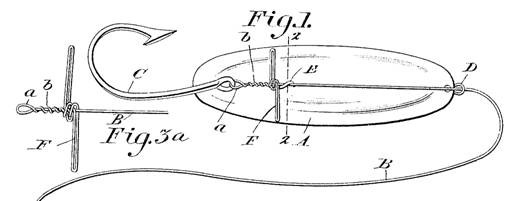
The object of
the design was “…to provide a simple, comparatively inexpensive spoon bait in
which the distance the trolling spoon may slide after the fish has been hooked
is practically unlimited and in which the spoon and hook are forced to revolve
or spin in unison, whereby the hook is always held in proper relative position
with the spoon…” He described a “snood” made of wire to which the hook was
connected and a crossbar which limited the approach of the spoon to the hook
and also allowed the spoon to slide away from the hook the entire length of the
snood.
In 1922
Evans applied for another patent. Patent number 1,467,362 was granted on
September 11, 1923.
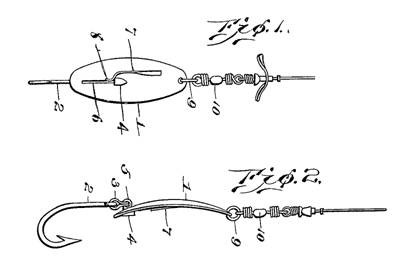
This design
was for “…improved mounting of the hook on the trolling spoon, to render it
impossible for the fish to pry its jaw loose from the hook when once fast”. In
the new design Evans described a block which held the hook in place preventing
it from swinging until a fish struck the lure, The jerk given by the fish
would release the hook from the block and allow it to travel the length of a slot
in the spoon, allowing it to swing freely. This would prevent the fish from
using the spoon as a fulcrum to pry the hook out of its jaw.
The new
design for hook mounting was so good that Evans undertook to produce a lure
incorporating the improvement. The Fort Myers Press reported in December 1925
“marking the consummation of years of study and work by Capt. E.L. Evans, dean
of Fort Myers fishermen, the Evans Pflueger ‘self-striker’, a new spoon hook
guaranteed to hold any fish that nabs it, is soon to be placed on the market
throughout the world…..After a year of negotiations, Captain Evans, who is the
inventor of many similar devices, recently obtained basic patents on the new
spoon and entered into a contract with the Enterprise Manufacturing Company of
Akron, Ohio for its manufacture”.
In 1926
Charles T. Pflueger applied for a patent for a Striker Spoon that incorporated
Evans design. That same year Enterprise Manufacturing Company introduced the
Pflueger-Evans Self Striker Spoon. C.T. Pflueger was granted patent 1,700,332
on January 29, 1929 and it was assigned to Enterprise Manufacturing Company of Akron, Ohio.
The patent application described the same method of securing the hook from
swinging freely that Evans had previously detailed. It also described the self
striker action of the spoon. “The striking action referred to is obtained by
mounting the hook in one position upon the spoon so that it will be released
momentarily and allowed to travel along the spoon for a short distance, the
movement of the hook being abruptly terminated so that the fish is securely
impaled upon the hook”.
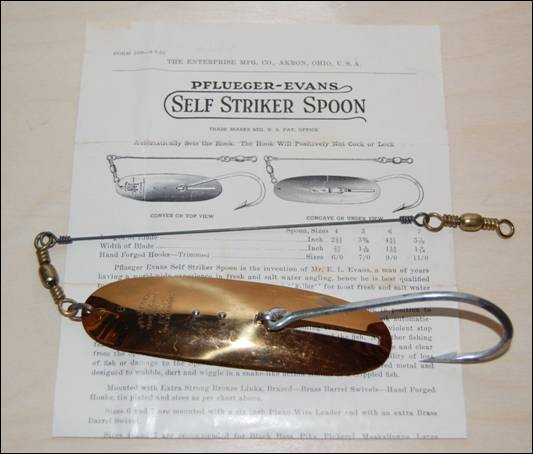
The #6 spoon shown here is one that was actually owned by Zane Grey. It
is one of three that came from Zane Grey’s personal steamer trunk #44, which
accompanied him on his 1939 trip to Australia. Both the trunk and its contents
were sold at auction in recent years.
Paperwork for the first spoons noted that “Pflueger Evans Self Striker Spoon is
the invention of Mr. E.L. Evans, a man of years having a world-wide experience
in fresh and salt water angling, hence he is best qualified to design the Self
Striker Spoon which has proven a ‘killer’ for most fresh and salt water fish”.
The metal spoons were inscribed with the Sept. 11, 1923 date of Evans patent.
The spoon was made in two finishes until 1931: polished Diamolite on
nickel and polished gold. It was made only in polished Diamolite after 1931.
Diamolite was a Pflueger trademark for a chrome finish. The spoon shown above
is finished in polished gold. The lure was available in four sizes:
|
Size 4 |
Size 5 |
Size 6 |
Size 7 |
Length of
Blade |
2-23/32 |
3-3/8 |
4-37/64 |
5-7/16 |
Width of
Blade |
29/32 |
1-1/16 |
1-19/64 |
1-9/16 |
Hand Forged
Hooks - Trimmed |
6/0 |
7/0 |
9/0 |
11/0 |
The two smaller sizes were designed for fresh water fish, while sizes 6 and 7
were recommended for Tarpon, Tuna, Swordfish, Kingfish, and Barracuda.
Pflueger continued production of the Self Striker Spoon into the 1950’s.
Captain Edward
Lewis Evans passed away on April 2, 1934. Visitors to Fort Myers today might
pass through Evans Park, where City Hall now stands. Evans acquired the
property in 1890 and built his home there before selling the property to the
City in 1921. The park stands as a reminder of one of Fort Myers early
settlers and beloved citizens.

Special
thanks to Edward “Ted” W. Evans, Jr., great grandson of Edward Lewis Evans, for
supplying photographs and information helpful in preparation of this story. Anyone
interested in learning more about Captain E.L. Evans would be well served to
study the family archive at the Fort Myers History Museum.
|






